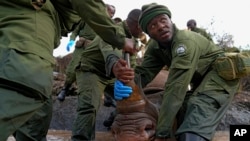LOISABA CONSERVANCY, Kenya —
Kenyan conservationists are rejoicing as rhinoceroses were reintroduced to a grassy plateau that has been without them for many years.
Kenya’s recent relocation of 21 eastern black rhinos to a new habitat has the potential to promote breeding and potentially boost the population of these critically endangered animals. This relocation effort is the largest ever undertaken by Kenya.
The rhinos were relocated from three parks that are facing issues of overcrowding to the privately owned Loisaba Conservancy, where herds were previously decimated due to poaching.
Daniel Ole Yiankere, security manager at Loisaba, stated that it has been several decades since rhinoceroses were present in this area, approximately 50 years ago. He further explained that their population was greatly affected by poaching. Currently, the main goal is to revitalize the environment in order to facilitate the breeding of rhinos, with the hope of restoring their population to its previous magnificence.
Transporting rhinos poses a significant obstacle. The task, which spanned over 18 days, required monitoring the rhinos from a helicopter and administering tranquilizers. Afterward, the creatures, weighing approximately one ton each, must be carefully loaded onto a truck for relocation.
The relocation process was almost disrupted when a rhino, who had been sedated, fell into a stream. A team of veterinarians and rangers used a rope to keep the rhino’s head above water until a reversal medication could take effect. Eventually, the rhino was freed.
A group of rhinoceroses were relocated from Nairobi National Park, traveling a distance of 300 kilometers. Additional rhinos were sourced from two parks in closer proximity to Loisaba.
Rhinos are generally solitary animals and are at their happiest in large territories. As numbers in the three parks where the rhinos were moved from have increased, wildlife officials decided to relocate some in the hope that they will be happier and more likely to breed.
According to David Ndere, a rhino specialist with the Kenya Wildlife Service, excessive numbers of rhinos in a given area can lead to a decrease in their reproduction rates.
Ndere stated that removing certain animals would result in an increase of the rhino population in those locations. The plan is to then reintroduce a minimum of 20 animals into new areas as a founder population.
Loisaba Conservancy said it has dedicated around 25,000 hectares to the new arrivals, which are a mix of males and females.
Conservationists report that Kenya has had moderate success in increasing its population of black rhinos. In the 1970s, the population dropped to under 300 due to poaching, causing concern that the species may be completely eradicated in the country. However, the current population stands at approximately 1,000 black rhinos, making it the third largest population after South Africa and Namibia.
According to the Save the Rhino organization, there are approximately 6,400 wild black rhinos remaining in the world, all of which reside in Africa.
The CEO of Loisaba Conservancy, Tom Silvester, stated that Kenya’s goal is to increase its black rhino population to 2,000 within the next ten years.
“He stated that once our group reaches a count of 2,000, we will have successfully revived the population and restored their existence.”
In the past ten years, Kenyan officials have moved over 150 rhinos to new locations.
In 2018, an effort to relocate 11 rhinos resulted in tragedy as all of the creatures perished shortly after the move.
Investigations revealed that ten of the rhinos perished due to a combination of stress, dehydration, and starvation, which were exacerbated by salt poisoning as they attempted to acclimate to the higher salinity of their new environment. The remaining rhino was killed by a lion.
Subsequent to this, fresh protocols have been established for the capture and transportation of rhinos in Kenya. Silvester reported that examinations have been carried out on the water conditions at Loisaba.
The country of Kenya is currently the residence of the world’s only two northern white rhinos. In recent news, scientists have expressed optimism about the possibility of preserving this subspecies by successfully creating an embryo using previously collected eggs and sperm from white rhinos, and transferring it into a surrogate female black rhino. Unfortunately, the surrogate passed away due to an infection after a flood, but a postmortem revealed that she was pregnant.
Source: voanews.com




